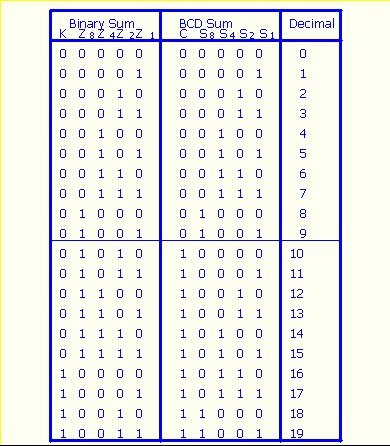Published by: Nuru
Published date: 22 Jun 2021

Binary Decimal Adder is a logic circuit that adds BCD digits in parallel and produces a sum digit also in BCD. It is also known as Decimal Adder. It has correction logic in its internal construction. Each input digit is less than or equal to 9 and the sum output can’t exceed 19 (9+9+1) where 1 is called input carry.

The input binary numbers are K, Z8, Z4, Z2, and Z1 where K is the carry and the subscript under each Z indicates the weight 8,4,2,1 which can be assigned to the 4 bits in BCD. The first column in the truth table represents the sum in binary form at the output of 4 bits binary adder and the second column indicates the sum in BCD. When the binary sum equals less than 1001, the corresponding BCD number is identical, and therefore no conversion is required. When the binary sum is greater than 1001, we can find no valid BCD representation.
The addition of binary six (0110) to the binary sum converts it into correct BCD representation and also produces the output carry as required. It is obvious that correction is required when the binary sum has an output carry K=1. The other six combinations from 1010 to 1111 need a correction, have 1 at Z8. Further, they also have 1 either at Z4 or Z2. Therefore, the combination of the correction and output carry can be expressed using the Boolean function.
C=K+Z8Z4+Z8Z2
When C=1, it is necessary to add 0110 to the binary sum and provide output carry to the next stage.